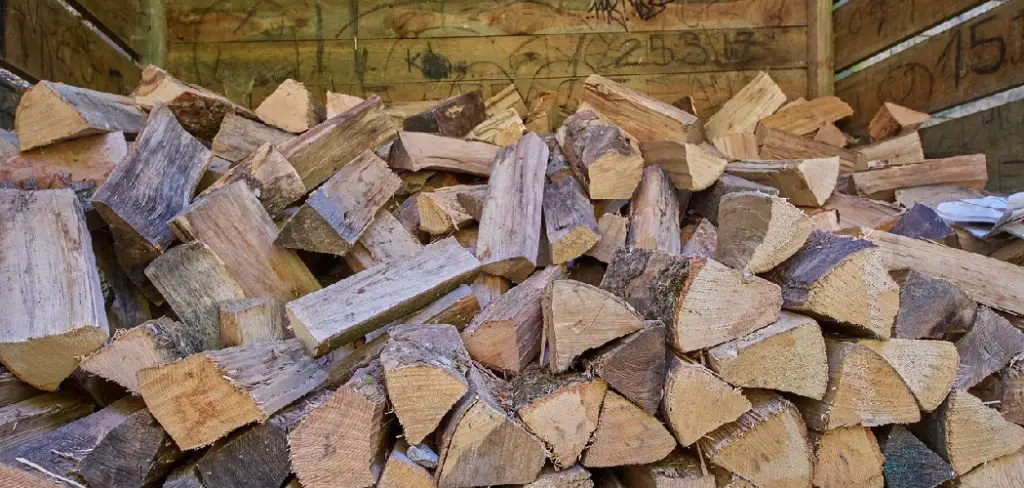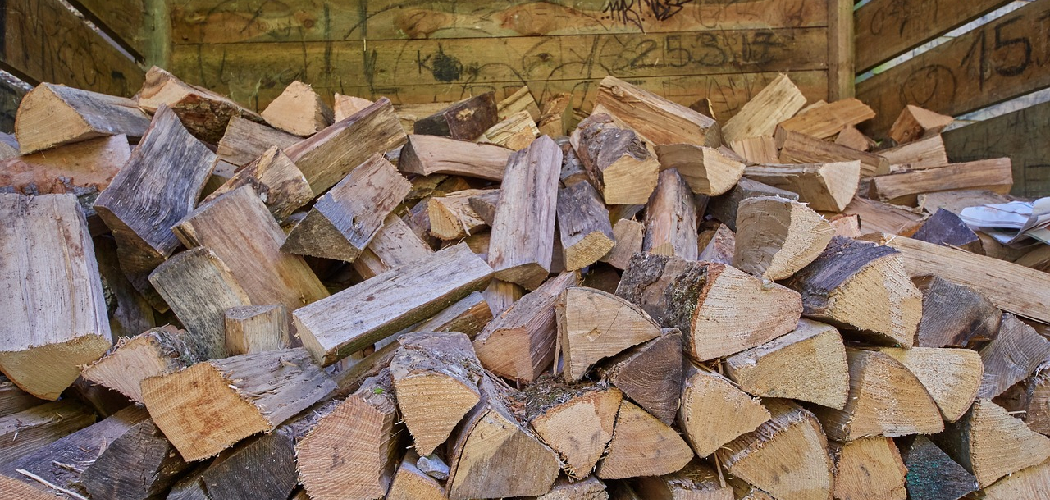Seasoning wood is a crucial step in making sure that the wood you use for your projects is properly dried and cured. Freshly cut wood can contain up to 50% moisture, which can negatively impact its strength, stability, and overall quality.

If you plan on using wood for construction, woodworking, or other projects, knowing how to season wood fast can save you time and money in the long run. In this blog post, we’ll share some tips and tricks to help you season wood quickly and efficiently.
Can You Season Wood Fast?
Wood is a beautiful and versatile material that can be used in countless ways. One of the essential steps in working with wood is seasoning, which involves drying it out to prevent warping, cracking, and other damage. Many people wonder if there’s a way to season wood faster than the traditional air-drying method.
While there are some techniques that can speed up the process, it’s crucial not to rush it too much. Seasoning wood too quickly can lead to internal stress and cause the wood to split or warp. So, while it may be tempting to try to accelerate the seasoning process, it’s best to be patient and let nature take its course.
Why Should You Season Wood Fast?
Seasoning wood is a crucial step in ensuring the longevity of your firewood. When freshly cut, wood retains a high level of moisture, making it difficult to burn efficiently. It’s essential to season wood fast, as this process allows the wood to dry out, making it lighter and easier to ignite. Additionally, seasoned wood produces less smoke and creosote, prolonging the life of your chimney while providing a cleaner burn.
When choosing to season your own wood, there are several techniques you can use to speed up the process. Ultimately, seasoning your wood fast is worth the effort and investment, as it will ensure a more enjoyable and healthier fire for you and your family.

How to Season Wood Fast: Tips and Tricks to Get the Job Done
1. Choose the Right Type of Wood
The type of wood you are trying to season can greatly impact how fast it dries. Hardwoods such as oak, hickory, and maple, for example, dry slower than softwoods such as pine or spruce.
If you want to maximize the rate of drying, it’s generally recommended to choose softwoods for your project. Some softwoods, like cedar or redwood, have natural resins and oils that help protect them from moisture, which can also make them more resistant to decay or rot.
2. Cut Your Wood Into Smaller Pieces
The smaller your wood pieces, the faster they will dry. This is because the surface area exposed to air is greater, which allows for moisture to evaporate more quickly. Chopping your wood into smaller pieces can be especially helpful if you’re trying to season larger logs or pieces of firewood. Use a saw or an axe to chop them into smaller logs or sections, making sure to wear protective gear like gloves and eye protection.
3. Increase Air Flow and Ventilation
Wood needs good air flow and ventilation to dry properly. If you’re using a woodshed or a storage area, make sure it’s open on all sides to allow for good air circulation. Avoid stacking your wood too tightly or covering it with tarps or plastic, as this can trap moisture and slow down the drying process. If you have a lot of wood to season, consider using a fan or a dehumidifier to increase air flow and reduce humidity.

4. Use a Moisture Meter
One of the best ways to know when your wood is sufficiently dry is by using a moisture meter. These handy devices can help you accurately measure the moisture content of your wood, allowing you to know when your wood is ready for use. You can pick up a moisture meter at your local hardware store or online, and they usually cost less than $50. Make sure to use your moisture meter regularly to track the drying progress of your wood.
5. Consider Using a Kiln
If you need your wood to dry at a faster rate, consider using a kiln. Kiln-drying can accelerate the drying process by several weeks or months, depending on the thickness and moisture content of your wood.
Some hardware stores and lumberyards offer kiln-drying services, or you can purchase a small kiln for home use. However, keep in mind that kiln-dried wood may be more expensive than air-dried wood, and it may also have a higher moisture content, depending on how long it has been since it was dried.
6. Use Proper Storage Techniques
Once your wood is dry, it’s important to store it properly to prevent moisture from re-entering the wood and slowing down the drying process. Make sure to keep your wood in a dry area with good air flow and ventilation. Also, try not to stack your wood too tightly or cover it with plastic as this can trap moisture and cause your wood to become damp again.

7. Treat the wood with a sealant or oil
Once your wood is dry, you can treat it with a sealant or oil to help protect the wood from moisture and decay. This will also help add extra protection against UV rays, mildew, and other outdoor hazards. Make sure to use a product that is designed for outdoor use, and apply the sealant or oil as per the manufacturer’s instructions.
Following these tips can help you season your wood quickly and efficiently. Remember, seasoning wood correctly is an important step in ensuring the quality of your projects. If done properly, it can add years of life to your woodworking projects!
5 Considerations Things When You Need to Season Wood Fast
1. Temperature
When seasoning wood quickly, temperature is an important factor to consider. Wood should be seasoned in a warm, dry environment with temperatures between 70 and 80 degrees Fahrenheit. If the temperature is too low, the drying process will take longer; if it is too high, the wood can become brittle and crack. Additionally, humidity levels should be kept low for optimal results.
2. Type of Wood
The type of wood being seasoned also plays a role in how quickly it can be done. Hardwoods such as oak and walnut are more difficult to season than softwoods like pine or cedar because they contain more moisture and take longer to dry out completely. It is important to select the right type of wood for your project in order to ensure that it seasons quickly and evenly.
3. Thickness
The thickness of the wood also affects how quickly it can be seasoned. Thicker pieces of wood will take longer to dry out than thinner pieces, so if you need to season your wood quickly you should opt for thinner pieces. This will help speed up the seasoning process while still providing you with quality results.

4. Air Flow
Air flow is also an important factor when seasoning wood quickly because it helps promote evaporation, speeding up the drying process. Ensure adequate air flow around your wood by keeping windows open or using fans or dehumidifiers if necessary. Additionally, make sure that any nearby objects are not blocking air flow around your wood so that it can dry evenly and quickly without any hot spots or wet spots forming on its surface.
5. Time
Finally, time plays an important role when seasoning wood quickly as well since some woods may take several days or even weeks to fully dry out depending on their thickness and type of wood used. Make sure that you give yourself enough time for your project so that you don’t have to rush through the process and end up with sub-par results due to a rushed job!
5 Benefits of Season Wood Fast
1. Durability
Seasoned wood is more durable than unseasoned wood, as the drying process helps to remove moisture and prevent rot and decay. Seasoning also makes the wood less susceptible to warping and splitting, which can be a problem with unseasoned wood. Additionally, seasoned wood is easier to work with as it is less likely to splinter or crack when cut or drilled.
2. Improved Burn Quality
Seasoned wood also burns better than unseasoned wood, producing more heat and fewer sparks. The drying process removes most of the water from the wood, meaning less steam is produced when it is burned. This results in a hotter fire that will burn for longer periods of time with fewer sparks and smoke.
3. Reduced Smoke Pollution
The burning of unseasoned wood can produce large amounts of smoke pollution due to its high moisture content. The smoke produced by burning unseasoned wood contains higher levels of carbon monoxide, particulate matter, and other pollutants that can be harmful to human health. Burning seasoned wood produces significantly less smoke pollution than burning unseasoned wood.
4. Cost Savings
Using seasoned wood instead of unseasoned wood can also save you money in the long run due to its increased durability and improved burn quality. Seasoning your firewood can be a cost-effective way to ensure that you always have a reliable fuel supply for your fireplace or stove without having to pay for pre-seasoned logs from a store or supplier.

5. Easier Storage
Seasoned firewood is also easier to store than unseasoned firewood as it takes up less space due to its reduced moisture content. Unseasoned firewood requires more storage space due to its high water content, which means that you may need larger storage areas if you are using unseasoned logs for your fireplace or stove.
Seasoned wood can be stored in smaller spaces, making it an ideal choice for anyone who doesn’t have a lot of room to spare.
Some Common Mistakes People Make When Trying to Season Wood Fast
When it comes to seasoning wood, patience is key. It’s understandable, though, that many people want to speed up the process. Unfortunately, trying to rush the seasoning process often leads to mistakes that can be detrimental to the quality of the finished product. One common mistake is burning the wood before it is properly dried out. This not only puts a damper on the wood’s quality but also increases the risk of splitting.
Another mistake people make is trying to season wood indoors, which can lead to mold growth. It’s important to remember that when it comes to seasoning wood, slow and steady wins the race. Rushing the process often results in a subpar end product.
Conclusion
Seasoning wood is an essential step in making sure that the wood you use for your projects is properly dried and cured. By following these tips and tricks, you’ll be able to season your wood quickly and efficiently, ensuring that it’s ready to use in no time.
Remember to choose the right type of wood, cut it into smaller pieces, increase airflow and ventilation, use a moisture meter, and consider using a kiln if you need to speed up the process. By doing this, you can be confident that your wood will be strong, stable, and ready for whatever project you have. Thanks for reading our post about how to season wood fast.

